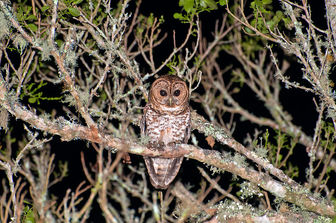Rusty-barred Owl
They are medium-sized owls, 33 to 38 centimetres long, and weighing 285 to 340 grams . Their body and breast are rust-coloured, and they have a brown barring, hence their common name. They have dark eyes set in a rusty coloured heads. They also have a pale buff barring their upper parts.

Original source: Dario Sanches from São Paulo, Brazil
Author: Dario Sanches from São Paulo, Brazil
The Rusty-barred Owl is classified as Near Threatened (NT), is close to qualifying for or is likely to qualify for a threatened category in the near future.
The Rusty-barred Owl (Strix hylophila) is a species of owl distributed mainly in the south of Brazil (where it is known as the Brazilian Owl) and further inland to Paraguay and the extreme northeast of Argentina. The Rusty-barred Owl is one of only a few members of the Strix genus to be found in South America. It is elusive and probably quite rare, and as a result has been little studied. More
A fact from Rusty-barred Owl appeared on Wikipedia's Main Page in the Did you know? column on 22 May 2007. The text of the entry was as follows: "Did you know * ...that the Rusty-barred Owl is one of the only two members of the Strix genus of birds to be found in South America?" Wikipedia An image would be nice, as well as help completing the taxobox - my sources are limited. More
Rusty-barred Owl - Picture 5 of 10 in Jennifer Coates Artist: Jennifer Coates All images subject to More
"The Rusty-barred Owl (Strix hylophila) is a species of owl distributed mainly in the south of Brazil (where it is known as the Brazilian Owl) and further inland to Paraguay ..." – read more… See them here - * London Zoo In London, United Kingdom. Visit their official website. More
* Rusty-barred Owl An adult in spotlight at night. Intervales State Park, São Paulo, Brazil (Monotypic species) Bradley Davis 7 April 2008 23 weeks ago 3 * A perched bird. More
separate occasions at Cristalino, pre-dawn Rusty-barred Owl at Agulhas Negras Road, the fabulous Frilled and Festive Coquettes, Black and Gold Cotinga and amazing views of tapaculos and antthrushes. On the mammal front several sightings of Tapir, Maned Wolf and the strange Giant Anteater at Canstra were also memorable. We didn't miss too much although the endemic Bare-eyed Antbird and Black-spotted Bare-eye were the biggest dips and our efforts to see Black-throated Piping Guan went unrewarded. More
Family : Strigidae
Genus : Strix
Species : hylophila
Authority : Temminck, 1825
